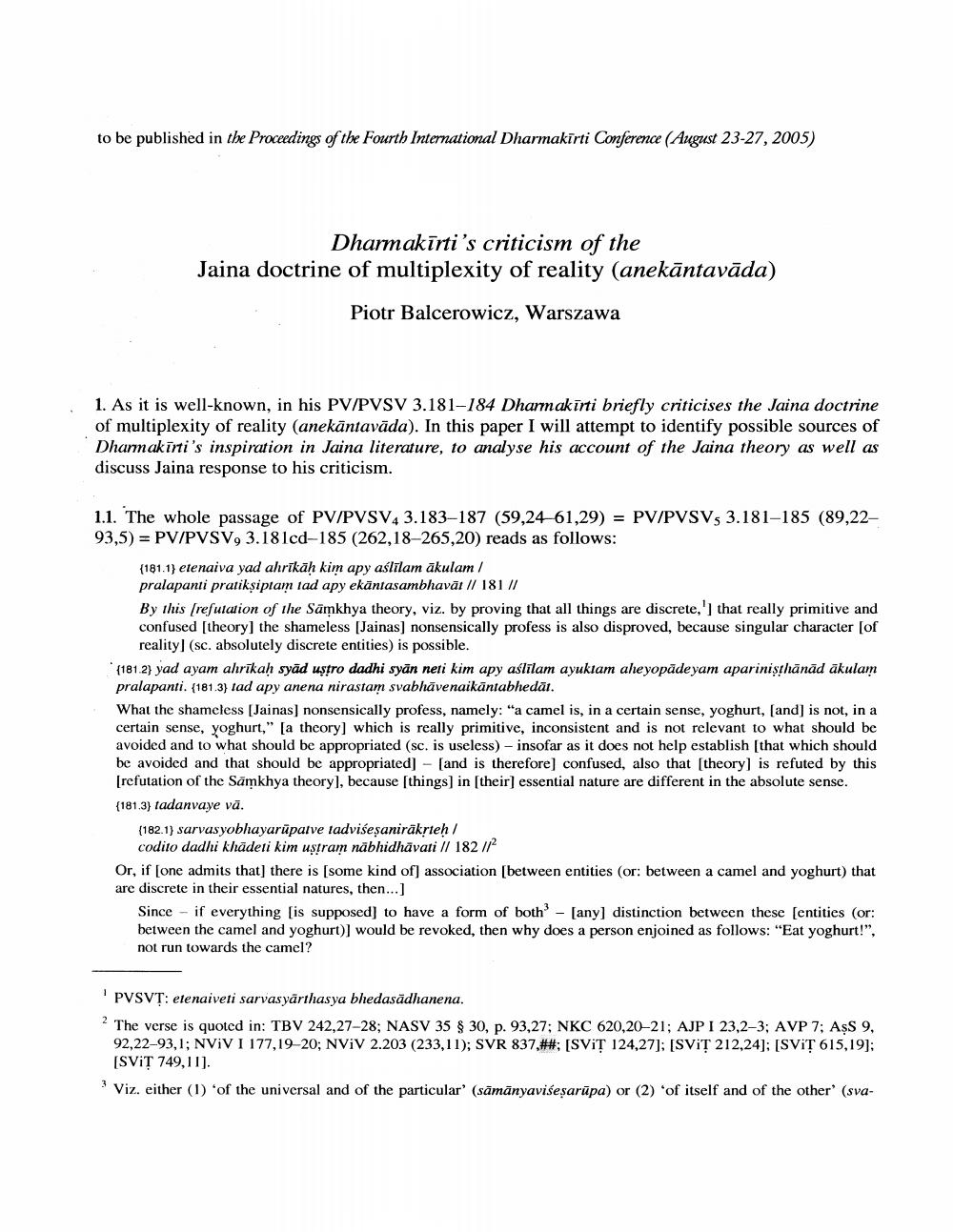________________
to be published in the Proceedings of the Fourth International Dharmakīrti Conference (August 23-27, 2005)
Dharmakīrti's criticism of the Jaina doctrine of multiplexity of reality (anekāntavāda)
Piotr Balcerowicz, Warszawa
1. As it is well-known, in his PV/PVSV 3.181-184 Dharmakīrti briefly criticises the Jaina doctrine of multiplexity of reality (anekāntavāda). In this paper I will attempt to identify possible sources of Dharmakīrti's inspiration in Jaina literature, to analyse his account of the Jaina theory as well as discuss Jaina response to his criticism.
1.1. The whole passage of PV/PVSV4 3.183-187 (59,2461,29) = PV/PVSV, 3.181-185 (89,22– 93,5) = PV/PVSV, 3.181cd-185 (262,18–265,20) reads as follows:
(181.1) etenaiva yad ahrīkāh kim apy aslilam akulam / pralapanti pratiksiplam tad apy ekäntasambhavāt // 181 // By this (refutation of the Sāmkhya theory, viz. by proving that all things are discrete,'] that really primitive and confused [theory] the shameless (Jainas) nonsensically profess is also disproved, because singular character [of
reality] (sc. absolutely discrete entities) is possible. (181.2) yad ayam ahrikah syad ustro dadhi syān neti kim apy aslilam ayuktam aheyopädeyam aparinisthänād akulam pralapanti. (181.3) tad apy anena nirastam svabhāvenaikāntabhedät. What the shameless [Jainas) nonsensically profess, namely: "a camel is, in a certain sense, yoghurt, (and) is not, in a certain sense, yoghurt," [a theory] which is really primitive, inconsistent and is not relevant to what should be avoided and to what should be appropriated (sc. is useless) - insofar as it does not help establish [that which should be avoided and that should be appropriated] - [and is therefore] confused, also that [theory) is refuted by this [refutation of the Samkhya theoryl, because [things) in (their) essential nature are different in the absolute sense {181.3) tadanvaye vā.
(182.1) sarvasyobhayarūpalve tadviseşaniräkrteh /
codito dadhi khädeti kim ustram näbhidhävati // 182 112 Or, if [one admits that there is (some kind of) association [between entities (or: between a camel and yoghurt) that are discrete in their essential natures, then...)
Since - if everything [is supposed to have a form of both – [any) distinction between these [entities (or: between the camel and yoghurt)] would be revoked, then why does a person enjoined as follows: "Eat yoghurt!", not run towards the camel?
PVSVT: etenaiveti sarvasyārthasya bhedasädhanena. 2 The verse is quoted in: TBV 242,27-28; NASV 35 $ 30, p. 93,27; NKC 620,20-21; AJP I 23,2-3; AVP 7; AșS 9,
92,22-93,1; NViV I 177,19-20; NViV 2.203 (233,11); SVR 837,##; [SVIT 124,27]; [SVIT 212,24]: [SViȚ 615,19); [SVIT 749,11). Viz. either (1) 'of the universal and of the particular' (sāmānyavisesarūpa) or (2) 'of itself and of the other' (sva




